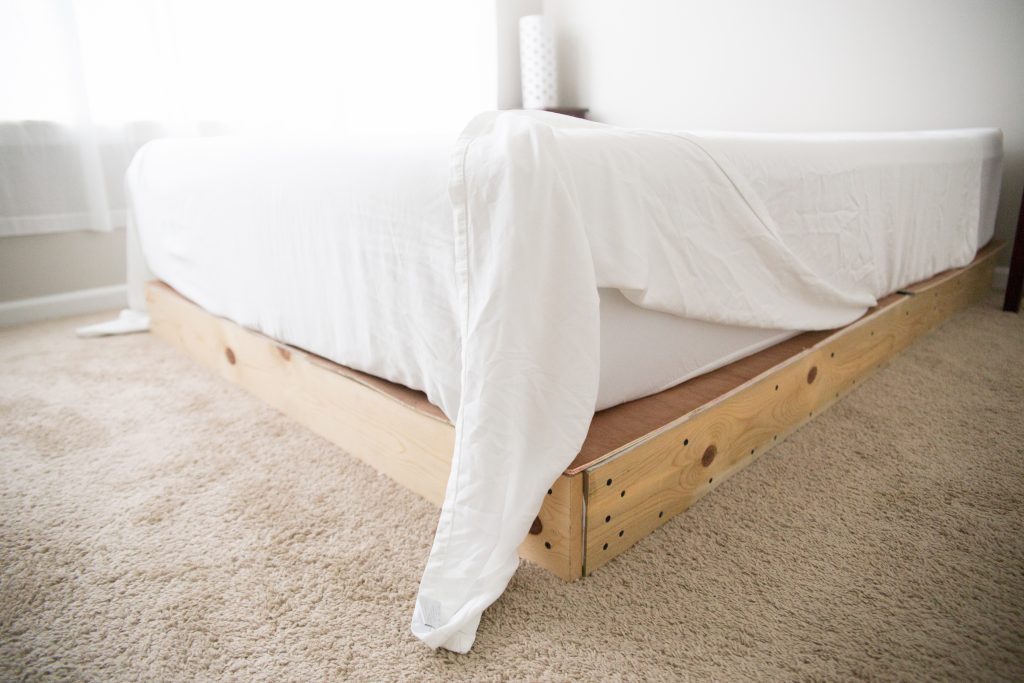Nothing is better than sliding into a cloud-like hotel bed and it is even better when it is your bed at home. One of the reasons we all love climbing into a hotel bed is by feeling all snuggly with the tightly fitted sheets. Making your bed with this step by step process will make this chore easy and will set a good tone for the rest of the day!

Step 1- Bottom Sheet
Make sure the bottom sheet is tucked tightly around the entire mattress. This is the base of the sheets!

Step 2- Top Sheet
Next, you will place your top sheet on the mattress. Lay this flat sheet 7-8 inches from the top of the mattress, so there is enough sheet to make and edges and to tuck in along the foot of the bed! Tuck in the sheet along the foot of the bed and leave out the corner sheets.

Step 3- Tackling on the Corners
The corners are probably the trickiest part of this entire process. But don’t be scared because once you do it once you will see how truly easy it is. To get the crisp, edges that hotel beds have is actually easier than it looks. Now let’s focus on the corners. Lift the sheet in half and tuck that “tail” part into the mattress, then take the other have and tuck that in to create a clean cut crease. Repeat this on the other side to matching corners!





Step 4- Comforter
Add your favorite comforter or duvet. Hotels usually use duvet covers over comforters to make the comforters nice and clean and have the comforter last longer. The duvet covers are typically 100% cotton to make it breathable.

Step 5- Fluffing your pillow
Next step is fluffing pillows! Hotel pillows are typically down and feather pillows, which require daily fluffing. To ensure your pillow stays full and lofty, squish the pillow in and out which pushes air into the down and feather clusters to make the pillow full! There is truly not a right or wrong trick to this however, daily fluffing is a big MUST do.


Step 6- Pillow protector
Next step is to put a pillow protector around your pillow. A pillow protector will help keep the pillow full and lofty! A secret tip to make this step a little easier is to fold the top two corners while using your arm in the middle of the pillow to flatten out the pillow. Slide the pillow into the pillow protector and release it once it is all the way in. Place the pillowcase over this using the same process. Fluff the pillow to have it sit nicely in the pillowcase. Next, by just grabbing the edge of the pillowcase, use a downward shaking motion to push the pillow to the bottom of the pillowcase. Next is a BIG housekeeping secret, do a fold and tuck with the extra pillowcase fabric to create a seal. Straighten out the edges to make a clean crease. This will method will tighten the pillowcase around the pillow and actually create a better feel and support of your pillows.






Step 7- Finishing Touches
Straighten out the pillows and make sure everything is wrinkle free! And that’s it! A hotel-quality bed in the comfort of your own home!

Bedding Expert Tips
What you need on your bed you ask?
4 pillows. 2 soft and 2 firm
Soft sheets
Comforter with a duvet cover
1 light weight blanket at the foot of the bed. THAT’S IT!
Our 5 top-selling hotel pillows are:
- Pacific Coast Down Surround Pillow featured in Many Marriott Hotels– https://www.pillows.com/pacodosupife.html
- Down Dreams Classic Firm Pillow featured in Many Hilton Properties– https://www.pillows.com/hilton-down-dreams.html
- Down Dreams Classic Soft Pillow featured in Many Hilton Properties– https://www.pillows.com/down-dreams-pillow-hilton.html
- Down Etc. 75% White Goose Feather/ 25% White Goose Down Pillow- Featured at St. Julien Hotel & Spa– https://www.pillows.com/st-julien-pillow-downetc.html
- Pacific Coast Double Down Surround Pillow- Formerly Featured in Many Ritz-Carlton Hotels- https://www.pillows.com/pacododosupi2.html
Hotel Duvets and Comforters
- Pacific Coast Down Comforters- retail version of the comforter used in many Marriott Properties – https://www.pillows.com/madoduc.html
- Asheville Comforter- Similar to the Comforter Found in Many Hilton Hotels– https://www.pillows.com/asheville-comforter-hilton.html
- Pillowtex ® Classic Weight Down Alternative Comforters / Duvets– https://www.pillows.com/piclwedoatco.html
- Pillowtex ® Hotel Cotton Duvet Cover -Blend Wrinkle Resistant– https://www.pillows.com/pillowtexhotelduvetcotton.html
*** Sheets used in above photos are from Pillows.com website – Cariloha Bamboo- Classic White Sheet Set- Queen- https://www.pillows.com/cbcssq.html











